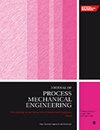Optimization of gas metal arc welding parameters for dissimilar steel welds: A case study on duplex stainless steel 2205 and stainless steel 316L
IF 2.2
4区 工程技术
Q2 ENGINEERING, MECHANICAL
Proceedings of the Institution of Mechanical Engineers, Part E: Journal of Process Mechanical Engineering
Pub Date : 2024-09-02
DOI:10.1177/09544089241272807
引用次数: 0
Abstract
The significance of welded connections in steel structures necessitates precise structural designs and processing adaptations to ensure robust mechanical strength and durability. Gas metal arc welding (GMAW) employing controlled curves presents advantages over conventional methods, offering enhanced weld bead properties, improved aesthetics, and reduced thermal inputs. This research investigates the impact of GMAW parameters using controlled curves on the microstructure and geometry of welds between dissimilar structural steels—duplex stainless steel 2205 and stainless steel 316L grade 50—commonly employed in construction. The aim is to optimize the GMAW welding process with controlled curves and surface tension transfer between these dissimilar steels. Through a 2优化异种钢焊接的气体金属弧焊参数:双相不锈钢 2205 和不锈钢 316L 案例研究
钢结构中焊接连接的重要性要求精确的结构设计和加工适应性,以确保牢固的机械强度和耐用性。与传统方法相比,采用可控曲线的气体金属弧焊(GMAW)具有增强焊缝性能、提高美观度和减少热输入等优点。本研究调查了采用受控曲线的 GMAW 参数对建筑中常用的异种结构钢(双相不锈钢 2205 和不锈钢 316L 50 级)之间焊缝的微观结构和几何形状的影响。目的是通过控制曲线和表面张力传递优化这些异种钢之间的 GMAW 焊接工艺。该研究采用 23 因子实验设计,包括进给速度 (Va)、电弧焦点 (FC) 和峰值到基点振幅 (APB),对焊接能量、几何形状、熔敷效率、微观结构、显微硬度、抗拉强度和腐蚀性能进行了研究。最佳焊接能量可促进微观结构的细化和硬度的均匀,有助于预测焊缝喉部区域。较高的能量水平会扩大热影响区和粗大晶粒,而较低的能量则会增加变异性。预测模型有助于微调焊接能量和焊缝面积,以获得理想的性能和穿透力,同时最大限度地减少干扰。通过采用限制焊接能量和曲线参数的推导方程,可以实现工艺优化,在成本、结构完整性和可靠性之间达到理想的平衡。
本文章由计算机程序翻译,如有差异,请以英文原文为准。
求助全文
约1分钟内获得全文
求助全文
来源期刊
CiteScore
3.80
自引率
16.70%
发文量
370
审稿时长
6 months
期刊介绍:
The Journal of Process Mechanical Engineering publishes high-quality, peer-reviewed papers covering a broad area of mechanical engineering activities associated with the design and operation of process equipment.

 求助内容:
求助内容: 应助结果提醒方式:
应助结果提醒方式:


